9 Reasons For Cat Biting Other Cat & Tips
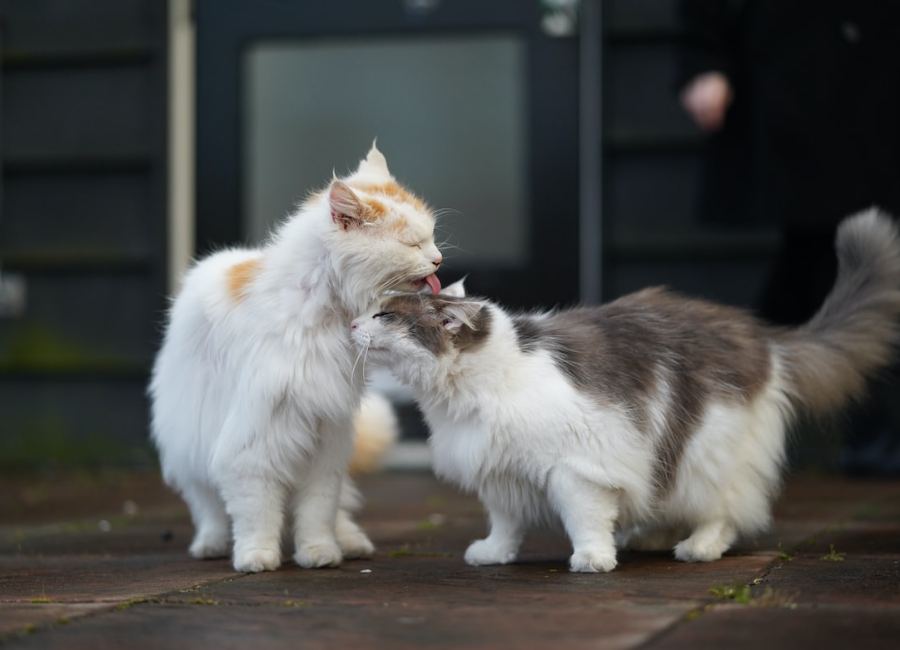
Let’s discuss the reasons for cat biting other cat…
Are you the proud parent of a furry feline? Chances are, if you have more than one cat, you’ve witnessed some playful (or not-so-playful) biting behavior between them.
While a little roughhousing is normal, excessive biting can cause harm and tension between your furry friends.
In today’s post, we’ll explore the reasons behind cat biting and how to prevent it. So, sit back, grab a cup of coffee, and let’s get to the root of this cat-tastic issue!
Why do cats bite each other?
Cats may bite each other for various reasons, including playfulness, social hierarchy establishment, mating behavior, or grooming.
Playful bites are reciprocal and usually harmless, involving stalking, chasing, pouncing, swatting, and biting.
However, bites that are related to social hierarchy establishment or mating behavior may result in aggression, especially if one cat feels threatened or challenged by the other.
Biting during grooming is another common behavior and may be used to remove parasites and get rid of matted spots.
Reasons for Cat Biting Other Cat
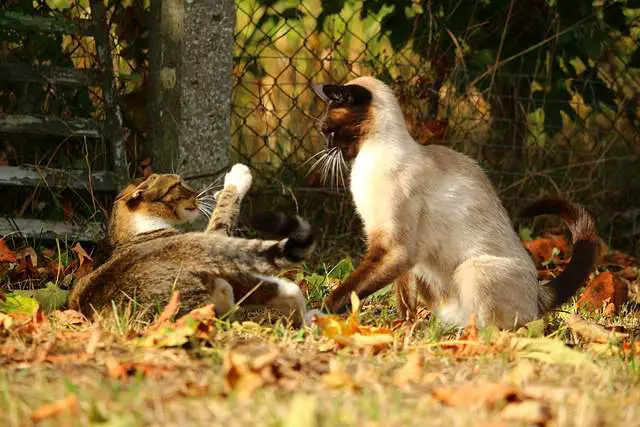
The following are some common reasons for cat biting other cat and how to handle it:
1. Territory and Resource Guarding
Due to the fact that cats are territorial creatures by nature, disputes may occur when one cat feels as though its territory or resources are being invaded.
Multiple resources should be available across the living area in order to address this.
For every cat, there should be a different set of food and water bowls, as well as resting places.
You avoid conflict and lessen the possibility of hostile interactions by doing this.
Offering plenty of vertical space, such as cat trees or shelves, thus enables each cat to define their own domain and lessens conflict.
2. Play Aggression
Cats occasionally become too excited while playing, which can result in rough behavior like biting.
It’s critical to promote acceptable play and shift their attention away from biting other cats in order to solve play aggressiveness.
To stimulate their innate hunting instincts, offer a range of interactive toys like wand toys or puzzle feeders.
Regularly engage in engaging play sessions with toys that keep your hands away from their teeth.
Give both cats a time-out to cool down if one of them starts to play with the other too roughly.
Play can be a great way to provide cats with plenty of mental and physical stimulation, which can help them release extra energy and lower their risk of acting aggressively.
3. Redirected Aggression
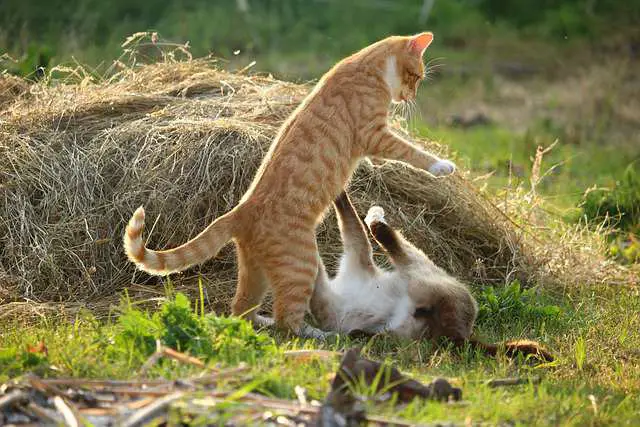
When they can’t find the source of their annoyance, cats may display redirected aggressiveness and bite other cats.
For instance, if a cat sees a bird through a window but is unable to catch it, they may concentrate their rage on another cat nearby.
To avoid more confrontation in these situations, it’s essential to separate the implicated cats. Make a diversion to draw their attention away from the trigger.
To do this, you can close the shutters or the curtains, occupy their attention with interactive toys like puzzle feeders, or give them a private space where they can relax.
Once they have calmed down and you want to avoid any lingering animosity, gradually reintegrate them.
4. Lack of Socialization
Unsocialized cats may find it difficult to coexist peacefully with other cats, leading to unnecessary biting issues.
It’s ideal for socialization to start from the kitten stage, but it’s never too late to make cats feel more at ease among other cats.
Key elements include gradual introductions under supervision. Start by letting the cats sniff each other through a gate or beneath a door before gradually moving on to supervised face-to-face interactions.
Use treats or praise as positive reinforcement to encourage calm, non-aggressive conduct.
Give each cat a private area to retreat to, so they can develop their own boundaries. They can develop acceptable habits and lessen aggressive inclinations with time and patience.
5. Personality Clashes
Cats can have personalities that clash, just like people, which can result in frequent arguments. It might be required to provide each cat its own dwelling space if you have tried several treatments without success.
This can entail allocating particular spaces or dividing areas with baby gates. Every cat has to have access to their own supplies, such as litter boxes, food, water, and resting spaces.
Consider arranging a rotation schedule so that each cat has access to different parts of the house at different times if separate places are not possible.
In more serious situations, seeking advice from a veterinarian or animal behaviorist with expertise in feline behavior might offer professional direction on how to handle the circumstance.
6. Overstimulation
When other cats approach their kittens, mothers’ cats may bite them as a kind of protection.
It’s crucial to provide the mother cat with a secure area during this time so she can take care of her babies.
Till the kittens are bigger and more independent, limit interactions with other cats.
Give the mother cat a private space to care for her kittens in peace and a place to breastfeed them.
Introduce supervised interactions with other cats to the kittens as they get older and more mobile so they can learn social skills.
7. Social Hierarchies
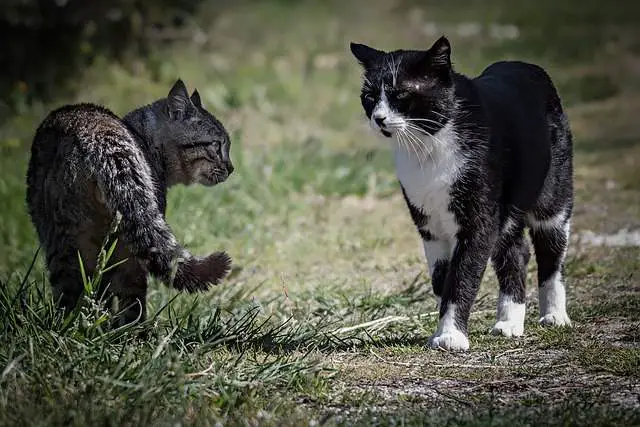
Within multi-cat families, cats create social hierarchies, and conflict can arise during the creation or maintenance of these dynamics. Make sure each cat has its own space and resources to solve this.
Separate food stations, litter boxes, rest places, and scratching posts are all part of this. Offering each person their own resources lessens rivalry and the chance of aggression.
Make sure to introduce a new cat to the family gradually and under supervision. By switching out the bedding or utilizing pheromone sprays to encourage good associations, you can encourage the cats to engage through smell exchange.
To create an orderly social hierarchy, reward and promote the cats’ cooperative behavior, such as playing or grooming one another.
Learn more about abandoned cat behaviors towards you and other pets.
8. Sexual Behavior
Unneutered cats, particularly males, may engage in aggressive behavior towards other cats due to sexual motivations.
In order to address this issue, it is highly recommended to consider spaying or neutering your cats.
By doing so, you can significantly reduce aggression associated with sexual behaviors.
It is always best to consult with your veterinarian to discuss the appropriate age for spaying or neutering your cats and to ensure the well-being of your feline companions.
9. Fear and Anxiety
Fear and anxiety can trigger defensive aggression in cats, causing them to bite other cats.
Identifying the source of fear, such as loud noises or new environments, and providing a safe and secure space for your cats can help alleviate cat anxiety.
Consult with a veterinarian or animal behaviorist for further guidance and consider using calming techniques like pheromone diffusers or anxiety-reducing products.
Steps to Address Cat Biting Other Cats
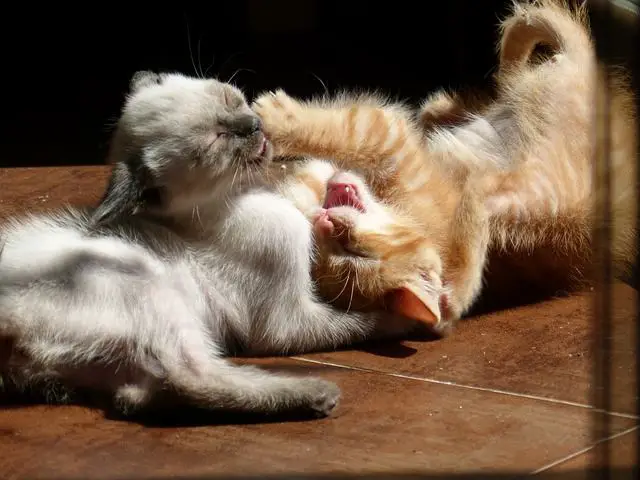
If you are dealing with a cat that is biting other cats, here are some steps you can take to address this behavior:
Separate the cats immediately: If the cats are currently living together, it may be necessary to separate them temporarily so that they can calm down and you can work on addressing the issues causing the aggressive behavior.
Identify the bite triggers: Observe the cats closely to try to identify what triggers the aggressive behavior. This could be anything from food or toy aggression to territorial issues or fear.
Provide each cat with its own resources: Make sure each cat has their own food, water, litter box, and comfortable resting areas. This can help reduce competition and prevent conflicts over resources.
Gradually reintroduce the cats: Once the cats have been separated and you have identified the triggers, you can work on gradually reintroducing them. This should be done slowly and carefully, with supervision, and with a plan in place for how to handle any aggressive behavior that may occur.
Consider consulting with a veterinarian or animal behaviorist: If the aggressive behavior persists despite your efforts, it may be beneficial to consult with a professional who can provide additional guidance and support.
Overall, addressing cat aggression toward other cats can be a complex process, but with patience and persistence, it is possible to improve the situation and create a harmonious environment for all of your furry friends.
Tips for preventing cats from biting each other
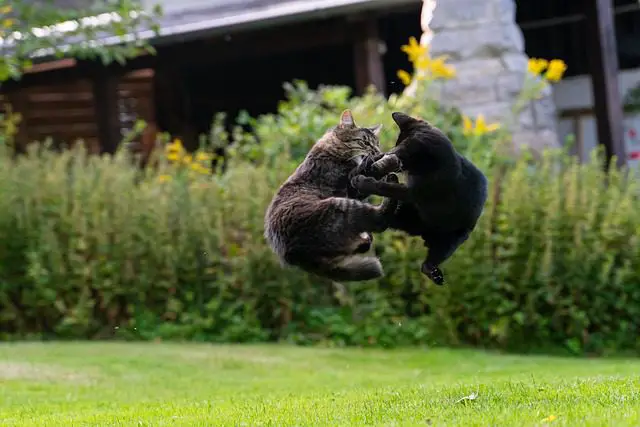
Here are some tips for preventing cats from biting each other:
- Spay or neuter your cats to reduce territorial aggression towards other cats.
- Socialize your kittens early on to help them learn appropriate play behavior.
- Provide plenty of toys for your cats to play with to reduce the need for them to play rough with other cats.
- Provide plenty of hiding spots and separate areas for your cats to retreat to if they feel threatened or overwhelmed.
- Avoid punishing your cats for aggressive behavior, as this can escalate the situation.
- Use positive reinforcement tactics, such as rewarding good behavior with treats or praise.
- Keep your cats separated during meal times to avoid food aggression.
- Monitor your cats’ playtime and separate them if their play becomes too rough.
- Seek professional help from a veterinarian or animal behaviorist if your cats consistently engage in aggressive behavior towards each other.
These tips can help promote a peaceful and harmonious environment for your cats to live in and reduce the risk of injury or harm caused by biting or other aggressive behavior.
How to handle a cat bite on other cats
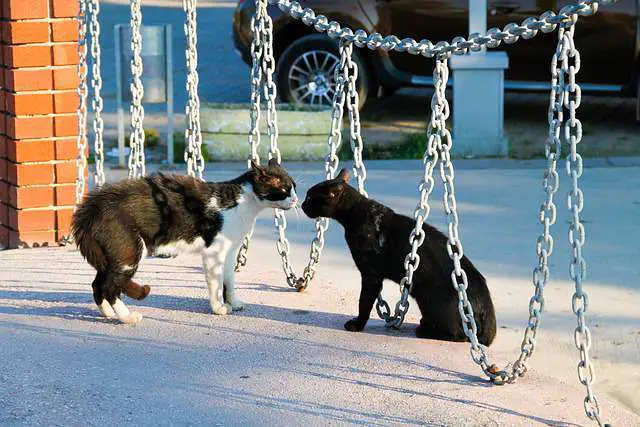
If your cat has been bitten by another cat, it is important to seek veterinary care promptly.
Your veterinarian will check the entire body, clean wounds properly with antiseptic, and recommend systemic cat antibiotics if needed.
In cats, over 90% of infected wounds result from cat bites sustained during a fight with another cat.
Therefore, it’s important to address the wound immediately to avoid potential infections.
Some of the best at-home solutions for cleaning a cat’s bite wound include using a first aid spray that is specifically designed for pet wounds.
It is also important to keep an eye on your cat for any signs of infection, such as fever, redness, swelling, or discharge from the wound.
If you notice any of these signs, it is important to contact your veterinarian right away for further guidance and treatment.
Learn more about cat behavior concerns.
Related Questions
Is it normal for cats to play bite each other?
Yes, it is normal for cats to play and bite each other. Play-biting is a natural behavior and a form of socialization for cats. However, it is important to encourage appropriate play and interrupt rough play if necessary to prevent injury.
At what point does cat biting become too aggressive?
Cat biting may become too aggressive when it causes injury to the other cat or if it is used as a means of dominance or territory establishment. It is important to seek veterinary advice or a cat behaviorist if the biting behavior becomes a persistent issue.
How can I stop my cat from biting other cats?
Preventing biting behavior involves discouraging rough play, offering plenty of space and resources to prevent fights over resources, and providing adequate environmental enrichment (such as scratching posts, toys, and hiding places). If biting behavior is a persistent issue, consulting a veterinarian or a cat behaviorist may also be necessary.
Is it possible for cats to bite out of fear?
Yes, it is possible for cats to bite out of fear. Fearful cats may bite as a defense mechanism when they feel threatened or cornered. It is important to provide a safe environment and create positive associations with the presence of other cats to reduce their stress and prevent fear-induced biting.
Can cats transmit diseases to each other through biting?
Yes, cats can transmit diseases to each other through biting. Some of the common diseases transmitted by cat bites include bacterial infections such as cat scratch fever and Pasteurella infection. It is important to seek immediate veterinary attention if a cat bite occurs to prevent the spread of infection.
Learn more about adopted stray cat behaviors.
Conclusion
In conclusion, if you have a cat that is biting another cat, it’s essential to take action to prevent serious injuries and avoid escalating tensions between your feline friends.
Remember to address any underlying health or behavioral issues, provide a safe and comfortable environment for all cats, and make positive associations with each other through playtime and treats.
With these tips, you can help your cats coexist peacefully and enjoy a happy, healthy life together.
So, don’t wait any longer and start implementing strategies to keep your furry companions safe and happy!
Pin it
